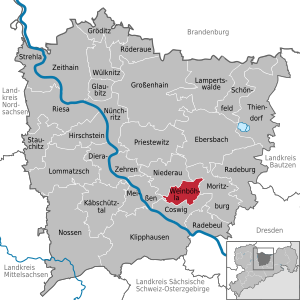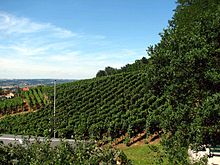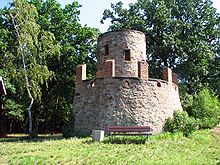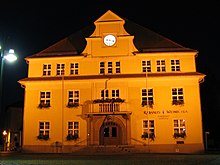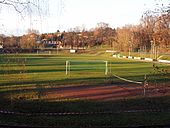Weinböhla
| coat of arms | Germany map | |
|---|---|---|
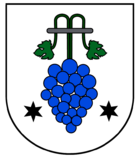
|
Coordinates: 51 ° 10 ′ N , 13 ° 34 ′ E |
|
| Basic data | ||
| State : | Saxony | |
| County : | Meissen | |
| Height : | 148 m above sea level NHN | |
| Area : | 19.02 km 2 | |
| Residents: | 10,342 (Dec. 31, 2019) | |
| Population density : | 544 inhabitants per km 2 | |
| Postal code : | 01689 | |
| Area code : | 035243 | |
| License plate : | MEI, GRH, RG, RIE | |
| Community key : | 14 6 27 310 | |
| Community structure: | 2 districts | |
| Address of the municipal administration: |
Rathausplatz 2 01689 Weinböhla |
|
| Website : | ||
| Mayor : | Siegfried Zenker ( CDU ) | |
| Location of the community Weinböhla in the district of Meißen | ||
Weinböhla is a municipality and a state-approved resort in the Saxon district of Meißen .
geography
Geographical location
Weinböhla is located in the densely populated Elbe valley on a southwest slope of the Elbe valley between Meißen and Coswig , with the latter the community has grown together. The Nassau extends west of Weinböhla and the Friedewald to the east . The exact geographical location is at 51 ° 10 'north latitude and 13 ° 34' east longitude at the location of the former post office. The most northeastern point of the municipality is the Heidehof in Friedewald, the southernmost is the Spitzberg on the border with Coswig. The westernmost is on the Gabenreichbach in Nassau. The lowest point of the municipality is 104 m above sea level. NN also on the Gabenreichbach in Nassau, the highest point is the lookout point of the watch tower (ruin) at 209 m. The largest body of water is the Gabenreichbach.
The area of the municipality covers 19.01 km². During the GDR era, Weinböhla was the country's largest village in terms of area.
Community structure
Weinböhla consists of the districts Weinböhla and New Cultivation .
geology
Characteristic of the geology of Weinboehla are mainly in the Cretaceous resulting sound and Kalkmergelablagerungen which were the basis for the former lime industry of the municipality as well as the eponymous Heidesand.
During the Saale Ice Age, this was carried by melting glaciers into the Elbe Valley. In terms of rocks, monzonite and the more silica-rich granite and granodiorite of the Lusatian granite massif are predominant. Other rocks are rhyolite deposits , gneiss and quartzite stones .
climate
The Elbe Valley belongs to the moderate Central European climate zone . The annual sunshine duration of 1500 to 1700 hours is favorable for viticulture .
Neighboring communities
Neighboring communities in the district of Meißen are the cities of Coswig and Meißen and the communities of Moritzburg and Niederau .
history
Weinböhla was first mentioned in 1349/50 in the feudal book of Friedrich des Strengen as "Bel", derived from the Old Sorbian "bela" (white, light). This original place name can be traced back to the sunny hillside location and the predominant heather sand soils. The old St. Martin's Church was probably built in the middle of the town center at this time . As it was then, it still has the shape of a Sorbian round today , later the settlements expanded to the north as an expanded square village.
The place received the suffix " Wein- " for the first time in 1513, as wine was already being grown here thanks to the favorable climatic conditions on the south-facing slope . After changing the spelling of the place name several times, the community has always been referred to as " Weinböhla " since 1692 .
On June 6, 1551, many houses burned down during a severe thunderstorm. The flames blazed so high and persistently that they were called the great fiery dragon . The incident went down as number 42 in the sagas of the Kingdom of Saxony by Johann Georg Theodor Grässer .
In addition to agriculture and viticulture, lime mining was of great importance between 1793 and 1870.
From the end of the nineteenth century, the place began to develop in its current structure. Between 1890 and the beginning of the First World War , Weinböhla experienced enormous construction activity, with the entire upper part of the village being built.
The inexpensive building land, the proximity to Dresden and Meißen , the beautiful scenic location and the already at that time favorable transport connections motivated many well-off people to settle here. The Imperial Health Department Berlin recommended Weinböhla as a climatic health resort .
After the consequences of the war and inflation had been overcome, the new town hall and two new residential areas were built in 1927 . In 1931 Weinböhla was directly connected to the state capital Dresden by the tram connection. The asparagus cultivation in the 1920s and 30s and the intensive fruit and vegetable cultivation up to the present day were also very important . The delivery area of the resident companies extended to Berlin .
Weinböhla has been involved in extensive construction work since 1990 to create a modern infrastructure , to renovate the old town center and to implement a new traffic concept.
The redesign of the town hall square, comfortable accommodation and leisure facilities as well as a large number of new residential buildings make the place more and more attractive for guests and residents.
After the reconstruction of the central inn , the foundation stone for the new foyer was laid on August 1, 1997, an event center of national importance has again been available here since 1999.
On the occasion of the 650th anniversary of Weinböhla, the Weinböhla local chronicle was published during the anniversary festival week.
Religions
→ Main article: St. Martin's Church in Weinböhla
There is an Evangelical Lutheran (St. Martin's Church) and a Roman Catholic church in Weinböhla.
Population development
Development of the population (December 31) :
| year | 1960 | 2002 | 2004 | 2005 | 2007 | 2008 | 2009 | 2010 | 2012 | 2013 | 2016 |
|---|---|---|---|---|---|---|---|---|---|---|---|
| Residents | 10,278 | 10,406 | 10,333 | 10,318 | 10.191 | 10,209 | 10.214 | 10,262 | 10,077 | 10,066 | 10,387 |
Data source from 2002: State Statistical Office Saxony
Memorials
- A memorial stone from the 1960s to the Dresdnerstraße reminiscent of three communist resistance fighter (s) who are victims of the Nazi dictatorship were: Helene Glatzer died in 1935 her mistreatment in the detention center Halle (Saale) , Paul Huth came in 1940 in the Buchenwald concentration camp killed , and Hellmut Türk died in the Hohnstein concentration camp in 1933 .
- At the village pond there is a memorial stone for the Red Army soldiers who fell in the vicinity of Weinböhla (In Russian; right next to it there is a sign with the German translation)
politics
Municipal council
Since the municipal council election on May 26, 2019 , the 18 seats of the municipal council have been distributed among the individual groups as follows:
- CDU : 9 seats
- BIW (Bürgerinitiative Weinböhla eV) : 3 seats
- LEFT : 1 seat
- SPD : 1 seat
- AfD : 4 seats
Mayor is Siegfried Zenker (CDU). He was elected to succeed Reinhart Franke on June 7, 2015.
| choice | voter turnout | CDU | BIW | LEFT | SPD | AfD | FDP | Schirmer |
|---|---|---|---|---|---|---|---|---|
| 2019 | 70.1 | 46.8 | 16.3 | 8.2 | 5.2 | 23.5 | ka | ka |
| 2014 | 53.8 | 51.4 | 20.0 | 12.0 | 7.3 | ka | 2.7 | 6.6 |
coat of arms
The Weinböhla coat of arms goes back to a seal image of the individual hoof index from 1764. The blazon reads: “In silver, a free-floating blue bunch of grapes on tall green rice with two outwardly sloping leaves bent over a black support wood. Below, next to the grape, two six-pointed black stars. "
Local partnerships
Weinböhla maintains a local partnership with Oftersheim in Baden-Württemberg .
Culture and sights
Museums
- Local museum
Buildings
- Lauben Castle from the 17th century is now used privately
- Peace Tower ( observation tower ). Built in 1903 as the Bismarck Observatory. Restored in 1956 and since then called the Peace Tower.
- King Albert Tower (observation tower). Built in 1898, completely refurbished in 1999.
- Wartturm (a restored ruin).
- Central inn
- Wolf Pillar Friedewald
Regular events
The winegrowers and street festival takes place every year on the first weekend in September. The artist market, every June, shows artists and their art.
carnival
The Weinböhla Carnival Association (WKV) was founded in 1969 as Elferrat Weinböhla. He has the self-created carnival call "Wambu-la".
sports clubs
The Turn- und Sportverein (TuS) Weinböhla has existed since 1885 and today has 791 members (as of January 1, 2020). In 1962 the association was renamed BSG Progress Weinböhla , and since 1990 it has had its original name again. At the moment there are football, gymnastics, running groups, gymnastics, aerobics, bowling, recreational sports and the heart group. Sports fields of TuS Weinböhla include the Nassauhalle and the Friedrich-Ludwig-Jahn sports facility.
In 2011 the handball department spun off from TuS and founded the handball sports club (HSV) Weinböhla .
The 1st tennis club Weinböhla 1994 uses the tennis facility on Spitzgrundstraße 82.
The Weinböhla cycling club was founded in 1906. It was originally called the Workers 'Cyclists' Association Free Goal . The members took part in competitions of artificial cycling, cycling polo and cycling ball. In cycling, they won the national championship twice in the 1920s and 1930s. The association is currently divided into the groups cycling, unicycling and historical cycling.
Economy, infrastructure and education
traffic
Weinböhla is connected to Autobahn 4 (A4) by state road 80 (S80) . The expansion of the S80 in Weinböhla via Köhlerstraße is controversial.
Weinböhla is in the area of the Upper Elbe transport association . The municipal area is crossed by the Dresden – Berlin and Dresden – Leipzig railways . When the timetable changed on December 15, 2002, the Weinböhla station on the line to Berlin was closed and a stop of the same name was opened on the line to Leipzig. The regional express lines Dresden - Leipzig and Dresden - Cottbus / Hoyerswerda as well as the regional train line Dresden-Elsterwerda (Biehla) stop there every hour . Two bus routes (411 and 421) operated by the Meißen transport company , which connect Weinböhla with the district town of Meißen, also end there. Others lead to Radeburg (403) and Großdobritz (459).
In addition, the end point of tram line 4 of the Dresdner Verkehrsbetriebe is in Weinböhla .
economy
The Weinböhla Specialist Clinic is a facility for weaning therapy for alcohol and / or drug dependent patients. The carrier is Ev.-Luth. Diakonenhaus Moritzburg e. V.
education
In Weinböhla there is a high school , which is under monument protection, as well as a primary school. Since the town does not have its own grammar school, students who strive for such an educational branch switch to grammar schools in the surrounding cities, such as Coswig, Radebeul or Meißen.
Personalities
Honorary citizen
- 2017: Reinhart Franke, long-time mayor
Sons and daughters of the church
- Karl Christoph Nestler (1740–1804), Protestant theologian
- Reinhold Langner (1905–1957), wood sculptor, architectural sculptor, draftsman and painter
- Erwin Gniza (1910–2006), pioneer of the German industrial safety theory
- Walter Bärsch (1914–1996), psychologist, special education teacher and educational scientist
- Joachim Specht (1931–2016), writer
- Manfred Höppner (* 1934), doctor
- Elisabeth Alter (* 1953), politician (SPD) and member of the state parliament of Brandenburg
Personalities who worked and are working on site
- Helene Glatzer (1902–1935), communist resistance fighter
- Peter Sodann (* 1936), actor and director
- Jörg Herchet (* 1943), composer
literature
- Cornelius Gurlitt : Weinböhla. In: Descriptive representation of the older architectural and art monuments of the Kingdom of Saxony. 41. Issue: Administrative Authority Meißen-Land . CC Meinhold, Dresden 1923, p. 522.
Web links
- Website of the municipality of Weinböhla
- Weinböhla in the Digital Historical Directory of Saxony
- Weinböhla . In: August Schumann : Complete State, Post and Newspaper Lexicon of Saxony. 12th volume. Schumann, Zwickau 1825, p. 535.
Individual evidence
- ↑ Population of the Free State of Saxony by municipalities on December 31, 2019 ( help on this ).
- ^ Moritz Grünewald. Teacher of the French language in Meissen: The Meissner Chronicle. From the construction of the city until 1588 . Printed by LG Rothe, [Grossen] Hayn 1829, first part, p. 162: “ On June 6th there was a very large thunderstorm, so that the rain and thunder lasted for three hours. In the village of Weinböhla, about an hour away from Meißen, a great fire had broken out in which many houses burned away. From the smoke of this fire rose a great, fiery dragon, which flew towards the Elbe and could be seen in the vicinity for a long time. At that time the common folk had the opinion of such dragons, as they were called natural fiery phenomena, that poisoners nourished them and used them for their thieves. "
- ↑ A fiery dragon moves towards Meissen . In: Dr. Johann Georg Theodor Grässer, King. Saxon. Hofrath, Director of KS Grünen Gewölbes and interim. Director of the porcelain and vessel collection, etc. etc ..: The treasure trove of the Kingdom of Saxony. For the first time in its original form from chronicles, oral and written records and other sources and published. Second improved and much increased edition, G. Schönfeld's Verlagsbuchhandlung, Dresden 1874, first volume, p. 52: “ 42) A fiery dragon moves towards Meißen. Faust aa OS 82. In 1551 a big fire broke out at Weinböhle near Meißen: towards evening one saw a large dragon pulling over the Elbe towards Meißen, which gave off long fiery rays. "
- ↑ Municipal election committee : Public announcement of the election results of the municipal council election on May 26, 2019 . In: Municipality of Weinböhla (ed.): Weinböhla Information . tape 2019 , no. 6 .
- ↑ https://www.statistik.sachsen.de/wpr_alt/pkg_s10_bmlr.prc_erg_bm_a?p_bz_bzid=BM151&p_ebene=GE&p_ort=14627310
- ↑ Communication and Public Relations Department: Election Results - sachsen.de. Retrieved April 27, 2020 .
- ↑ Communication and Public Relations Department: Election Results - sachsen.de. Retrieved April 27, 2020 .
- ↑ Bismarckwarte Weinböhla on bismarcktuerme.de
- ↑ a b Sights in Weinböhla - towers on weinboehla.de
- ↑ The association Wambula - Weinböhlaer Carnival eV Retrieved on 4 May 2020 .
- ↑ Home page with presentation of the club. Retrieved May 4, 2020 .
- ↑ Map of the sports arenas. Retrieved May 4, 2020 .
- ↑ HSV Weinböhla
- ↑ Imprint. Retrieved on May 4, 2020 (German).
- ↑ Our association - Weinböhla cycling association. Retrieved May 4, 2020 .
- ↑ Weinböhla residents want relief for Köhlerstraße: Numerous signatures for S 80 new. Retrieved May 4, 2020 .
- ↑ Announcement of the new stop in Weinböhla . In: Eisenbahn-Revue International , issue 4/2003, ISSN 1421-2811 , p. 152
- ↑ City traffic Coswig - Radebeul - Weinböhla. VVO, December 15, 2019, accessed on May 4, 2020 .
- ↑ Franke becomes an honorary citizen . Schwetzinger Zeitung, January 30, 2017

